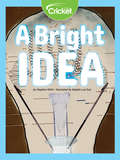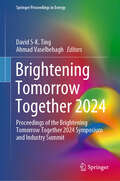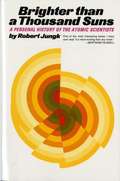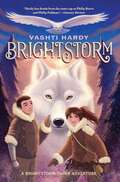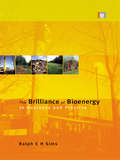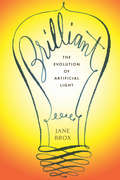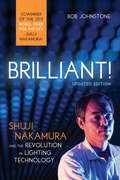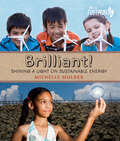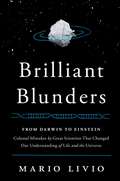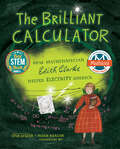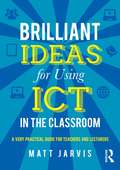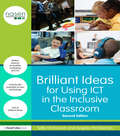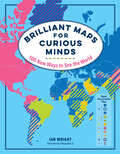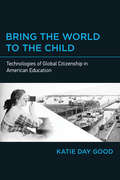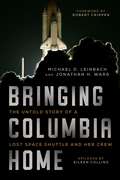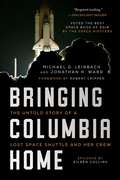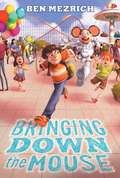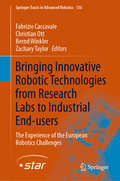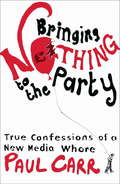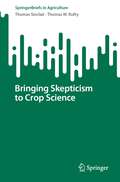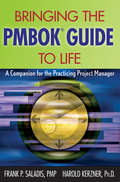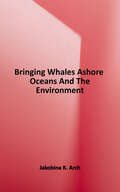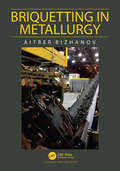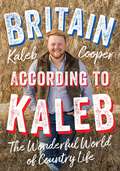- Table View
- List View
A Bright Idea
by Stephen WhittWhat does a light bulb require to burn bright? What happens when a light bulb burns out? Discover how filament, made of one of the heaviest metals, a mixture of two gases, a 60-watt light bulb, and electric currents make this bright idea more than just a bright light! The amazing science behind the light bulb awaits you!
Brightening Tomorrow Together 2024: Proceedings of the Brightening Tomorrow Together 2024 Symposium and Industry Summit (Springer Proceedings in Energy)
by David S-K. Ting Ahmad VaselbehaghThis book includes the proceedings of the Symposium and Industry Summit, June 20-21, 2024 at University of Windsor Negativity and pessimism seem to dominate the media in recent years, overshadowing the bright side of our beautiful planet and disheartening its inhabitants. Not to deny the prevailing challenges, but tomorrow is far from complete ruin and doom. Brightening Tomorrow Together aims at bringing optimists from many disciplines of expertise and walks of life together to synergise existing know-how and further the latest technologies and measures to hasten the brightening of tomorrow. This book is part of the big dream of the Turbulence and Energy Laboratory. It strives to bring together a diverse group to exchange state-of-the-art progresses and to promote collaborations across different disciplines to hasten the brightening of tomorrow together. Topics of interest include engineering cleaner energy, improving our understandings of water and wastewater, reducing waste and pollution at all fronts, and actualizing eco-friendly agriculture and living.
Brighter Than a Thousand Suns: A Personal History of the Atomic Scientists
by Robert Jungk James CleughAn account of the remarkable scientists who discovered that nuclear fission was possible and then became concerned about its implications. Index. Translated by James Cleugh.
Brightstorm: A Sky-ship Adventure (Brightstorm #1)
by Vashti HardyCritically acclaimed in the UK, Brightstorm is a fast-paced fantasy adventure novel that will set imaginations soaring. Arthur and Maudie Brightstorm receive devastating news: their famous explorer father has died in a failed attempt to reach South Polaris. To make matters worse, the Lontown Geographical Society finds Ernest Brightstorm guilty of sabotaging the expedition of his competitor, Eudora Vane. But a mysterious clue leads the twins to question the story they’ve been told—and to uncover the truth, they must undertake the journey of a lifetime. Joining the ragtag crew of a homemade sky-ship captained by the intrepid Harriet Culpepper, Arthur and Maudie race to South Polaris to salvage their family’s reputation and find out what really happened on their father’s doomed expedition. Brightstorm is a propulsive and compelling fantasy adventure set among the vibrant landscapes and dynamic characters of Vashti Hardy’s vividly imagined world.
The Brilliance of Bioenergy: In Business and In Practice
by Ralph E SimsThe time for modern biomass has come. It has long been overshadowed by other, more widely-publicized renewable energy technologies such as wind, solar and hydro, and still retains an outmoded image in comparison to its apparently more attractive cousins. The potential for biomass to act as a store of solar energy, and yet to be converted efficiently when required into heat, power, transport fuels and even substitutes for plastics and petrochemicals, is not widely appreciated. The increasing abundance of well-designed, successful bioenergy projects around the world is creating new interest in this renewable, sustainable and low-emission-producing source of energy. The Brilliance of Bioenergy covers all the main resources and technologies, principles, practice, social and environmental issues as well as the economics involved. The book also presents valuable, practical experiences - both 'how to' and 'how not to' - in the form of case studies of both small and large scale projects in both developed and developing countries. The Brilliance of Bioenergy is for those wishing to learn more about biomass, the technologies and the business potential. It will be welcomed by all involved in biomass production, bioenergy utilization, planning and development, and in renewable energies in general, as well as students, academics and researchers in the subject.
Brilliant: The Evolution of Artificial Light
by Jane BroxThis &“superb history&” of artificial light traces the evolution of society—&“invariably fascinating and often original . . . [it] amply lives up to its title&” (Publishers Weekly, starred review). In Brilliant, Jane Brox explores humankind&’s ever-changing relationship to artificial light, from the stone lamps of the Pleistocene to the LEDs embedded in fabrics of the future. More than a survey of technological development, this sweeping history reveals how artificial light changed our world, and how those social and cultural changes in turn led to the pursuit of more ways of spreading, maintaining, and controlling light. Brox plumbs the class implications of light—who had it, who didn&’t—through the centuries when crude lamps and tallow candles constricted waking hours. She identifies the pursuit of whale oil as the first time the need for light thrust us toward an environmental tipping point. Only decades later, gas street lights opened up the evening hours to leisure, which changed the ways we live and sleep and the world&’s ecosystems. Edison&’s bulbs produced a light that seemed to its users all but divorced from human effort or cost. And yet, as Brox&’s informative portrait of our current grid system shows, the cost is ever with us. Brilliant is infused with human voices, startling insights, and timely questions about how our future lives will be shaped by light
Brilliant!
by Bob JohnstoneA revolution in the way we use artificial lighting is underway, one that is every bit as sweeping and significant as Edison's invention of the light bulb. The technology of light emitting diodes (LEDs) is ready for widespread implementation. Its impacts will include a reduction in energy consumption for electric lighting by up to 80 percent.Brilliant! tells the story of Shuji Nakamura, a gifted Japanese engineer who came out of nowhere to stun the world with his announcement that he had created the last piece in the puzzle needed for manufacturing solid-state white lights. The invention of this holy-grail product, which promises to make Edison's light bulb obsolete, had eluded the best minds at the top electronic firms for twenty-five years. Until his startling announcement, Nakamura had not even been on the radar screen of most industry observers. Veteran technology writer Bob Johnstone traces the career of Nakamura, which included many years of obstinate individual effort as well as a dramatic legal battle pitting him against his former Japanese employer. Over a five-year span, Nakamura distinguished himself with an unprecedented series of inventions--bright blue, green, ultraviolet, and then white LEDs, plus a blue laser that will play an essential role in the next-generation DVD players. Then he was forced to leave Nichia Chemical, the company where he had worked for twenty years, and his former employer sued him. The result was a multimillion-dollar settlement in a landmark decision that acknowledged, for the first time, the rights of individual inventors working in a corporate context. Today, Nakamura holds a professor's chair at the University of California at Santa Barbara, where he continues to develop the technology of LEDs. Johnstone, the first Western journalist to meet and interview Nakamura, has received the brilliant engineer's full cooperation through a series of exclusive interviews given for the book. Johnstone has also interviewed other key players in the imminent lighting revolution, providing an exciting preview of the technological, entrepreneurial, and artistic creativity that will soon be unleashed by Nakamura's inventions.
Brilliant!: Shining a light on sustainable energy (Orca Footprints #3)
by Michelle MulderDid you know that cars can run on french-fry grease or that human poop can be used to provide power to classrooms? Brilliant! is about what happens when you harness the power of imagination and innovation: the world changes for the better! Kids in Mexico help light up their houses by playing soccer, and in the Philippines, pop-bottle skylights are improving the quality of life for thousands of families. Full of examples of unusual (and often peculiar) power sources, Brilliant! encourages kids to look around for new and sustainable ways to light up the world.
Brilliant Blunders: From Darwin to Einstein - Colossal Mistakes by Great Scientists That Changed Our Understanding of Life and the Universe
by Mario LivioDrawing on the lives of five great scientists, this “scholarly, insightful, and beautifully written book” (Martin Rees, author of From Here to Infinity) illuminates the path to scientific discovery.Charles Darwin, William Thomson (Lord Kelvin), Linus Pauling, Fred Hoyle, and Albert Einstein all made groundbreaking contributions to their fields—but each also stumbled badly. Darwin’s theory of natural selection shouldn’t have worked, according to the prevailing beliefs of his time. Lord Kelvin gravely miscalculated the age of the earth. Linus Pauling, the world’s premier chemist, constructed an erroneous model for DNA in his haste to beat the competition to publication. Astrophysicist Fred Hoyle dismissed the idea of a “Big Bang” origin to the universe (ironically, the caustic name he gave to this event endured long after his erroneous objections were disproven). And Albert Einstein speculated incorrectly about the forces of the universe—and that speculation opened the door to brilliant conceptual leaps. As Mario Livio luminously explains in this “thoughtful meditation on the course of science itself” (The New York Times Book Review), these five scientists expanded our knowledge of life on earth, the evolution of the earth, and the evolution of the universe, despite and because of their errors. “Thoughtful, well-researched, and beautifully written” (The Washington Post), Brilliant Blunders is a wonderfully insightful examination of the psychology of five fascinating scientists—and the mistakes as well as the achievements that made them famous.
The Brilliant Calculator: How Mathematician Edith Clarke Helped Electrify America
by Jan LowerHidden Figures meets Rosie Revere, Engineer in this STEM/STEAM picture book about Edith Clarke, the innovator who solved an electrical mystery and built the first graphing calculator—from paper!Long before calculators were invented, little Edith Clarke devoured numbers, conquered calculations, cracked puzzles, and breezed through brainteasers. Edith wanted to be an engineer—to use the numbers she saw all around her to help build America.When she grew up, no one would hire a woman engineer. But that didn&’t stop Edith from following her passion and putting her lightning-quick mind to the problem of electricity. But the calculations took so long! Always curious, Edith couldn&’t help thinking of better ways to do things. She constructed a &“calculator&” from paper that was ten times faster than doing all that math by hand! Her invention won her a job, making her the first woman electrical engineer in America. And because Edith shared her knowledge with others, her calculator helped electrify America, bringing telephones and light across the nation.
Brilliant Ideas for Using ICT in the Classroom: A very practical guide for teachers and lecturers
by Matt JarvisBrilliant Ideas for Using ICT in the Classroom is a totally practical, hands-on guide to using ICT in and around the classroom for all secondary school teachers and lecturers in post-compulsory education. Assuming no prior expertise, it centres on software and resources that are free or very low cost, and offers step-by-step guidance and creative ideas to improve the experience and engagement of your students. With a focus on what tools to use, what educational need they satisfy and how to incorporate them into good pedagogy, key topics covered include: Effective use of presentation technologies Using, producing and sharing multimedia Interactive whiteboards and related technologies Using Web 2.0 technologies Mobile learning Supporting diverse student needs through technology. Brilliant Ideas for Using ICT in the Classroom puts equal emphasis on both technical and pedagogical issues, making it the ideal companion whatever your ICT or e-learning needs. Catering equally well for Windows, Mac and Linux users, this book is designed to give you all the confidence you need to start teaching brilliantly with ICT.
Brilliant Ideas for Using ICT in the Inclusive Classroom (David Fulton / Nasen Ser.)
by Sally McKeown Angela McGlashonRunner up in Teach Secondary’s Technology and Innovation Awards 2014 sponsored by Lego, Brilliant Ideas for using ICT in the Inclusive Classroom provides lots of simple practical ideas showing teachers and support staff how they can use ICT to boost the achievement of all pupils. How can you use ICT to boost the achievement of all your pupils? This practical teachers’ guide will help you to unlock the enormous potential of new technology in order to enhance pupils’ learning, particularly for young people with additional needs. Written by two of the UK’s leading technology experts, this invaluable and newly updated resource will enable you to use ICT effectively to make lessons more accessible, motivating and fun. With fifty illustrated case studies and twenty starter activities, this practical resource will help you to introduce new technology into the inclusive classroom. It has been specifically designed to help develop your pupils’ key skills, such as problem solving, developing concepts and communicating to different audiences. In each activity, the authors show why and how a particular resource was used and show how similar techniques can be implemented to open up the curriculum to your learners. The authors include timely and realistic advice on how to use a range of technologies from the cheap and cheerful – and even free – to more sophisticated and specialist packages. Find out about: Apps Blogging Digital animation Podcasting Digital storytelling Wikis Geocaching Coding Games and gaming Sat nav Art packages Twitter Whether you’re already techno-savvy or looking to get started with ICT, this book is full of brilliant ideas on how to engage learners of all abilities using technology. If you’re looking for inspiration on how to integrate creative uses of ICT with the curriculum, this book will prove invaluable.
Brilliant Maps for Curious Minds: 100 New Ways To See The World (Maps for Curious Minds #0)
by Ian WrightA singular atlas of 100 infographic maps from thought-provoking to flat-out fun. And don’t miss the next book in the series, North American Maps for Curious Minds! Publisher’s note: Brilliant Maps for Curious Minds was published in the UK under the title Brilliant Maps. Which countries don’t have rivers? Which ones have North Korean embassies? Who drives on the “wrong” side of the road? How many national economies are bigger than California’s? And where can you still find lions in the wild? You’ll learn answers to these questions and many more in Brilliant Maps for Curious Minds. This one-of-a-kind atlas is packed with eye-opening analysis (Which nations have had female leaders?), whimsical insight (Where can’t you find a McDonald’s?), and surprising connections that illuminate the contours of culture, history, and politics. Each of these 100 maps will change the way you see the world—and your place in it.
Bring the World to the Child: Technologies of Global Citizenship in American Education (The\mit Press Ser.)
by Katie Day GoodHow, long before the advent of computers and the internet, educators used technology to help students become media-literate, future-ready, and world-minded citizens.Today, educators, technology leaders, and policy makers promote the importance of “global,” “wired,” and “multimodal” learning; efforts to teach young people to become engaged global citizens and skilled users of media often go hand in hand. But the use of technology to bring students into closer contact with the outside world did not begin with the first computer in a classroom. In this book, Katie Day Good traces the roots of the digital era's “connected learning” and “global classrooms” to the first half of the twentieth century, when educators adopted a range of media and materials—including lantern slides, bulletin boards, radios, and film projectors—as what she terms “technologies of global citizenship.”Good describes how progressive reformers in the early twentieth century made a case for deploying diverse media technologies in the classroom to promote cosmopolitanism and civic-minded learning. To “bring the world to the child,” these reformers praised not only new mechanical media—including stereoscopes, photography, and educational films—but also humbler forms of media, created by teachers and children, including scrapbooks, peace pageants, and pen pal correspondence. The goal was a “mediated cosmopolitanism,” teaching children to look outward onto a fast-changing world—and inward, at their own national greatness. Good argues that the public school system became a fraught site of global media reception, production, and exchange in American life, teaching children to engage with cultural differences while reinforcing hegemonic ideas about race, citizenship, and US-world relations.
Bringing Columbia Home: The Untold Story of a Lost Space Shuttle and Her Crew
by Michael Leinbach Jonathan Ward Eileen Collins Robert CrippenFor the first time, here is the definitive inside story of the Columbia disaster and recovery and the inspiring message it ultimately holds. <P><P>In the aftermath of tragedy, people and communities came together to help bring home the remains of the crew and nearly 40 percent of shuttle, an effort that was instrumental in piecing together what happened so the shuttle program could return to flight and complete the International Space Station. <P><P>Bringing Columbia Home shares the deeply personal stories that emerged as NASA employees looked for lost colleagues and searchers overcame immense physical, logistical, and emotional challenges and worked together to accomplish the impossible. <P><P> Featuring a foreword and epilogue by astronauts Robert Crippen and Eileen Collins, and dedicated to the astronauts and recovery search persons who lost their lives, this is an incredible, compelling narrative about the best of humanity in the darkest of times and about how a failure at the pinnacle of human achievement became a story of cooperation and hope.
Bringing Columbia Home: The Untold Story of a Lost Space Shuttle and Her Crew
by Jonathan H. Ward Eileen Collins Robert Crippen Michael D. LeinbachTimed to release for the 15th Anniversary of the Columbia space shuttle disaster, this is the epic true story of one of the most dramatic, unforgettable adventures of our time.On February 1, 2003, Columbia disintegrated on reentry before the nation’s eyes, and all seven astronauts aboard were lost. Author Mike Leinbach, Launch Director of the space shuttle program at NASA’s John F. Kennedy Space Center was a key leader in the search and recovery effort as NASA, FEMA, the FBI, the US Forest Service, and dozens more federal, state, and local agencies combed an area of rural east Texas the size of Rhode Island for every piece of the shuttle and her crew they could find. Assisted by hundreds of volunteers, it would become the largest ground search operation in US history. This comprehensive account is told in four parts: Parallel Confusion Courage, Compassion, and Commitment Picking Up the Pieces A Bittersweet VictoryFor the first time, here is the definitive inside story of the Columbia disaster and recovery and the inspiring message it ultimately holds. In the aftermath of tragedy, people and communities came together to help bring home the remains of the crew and nearly 40 percent of shuttle, an effort that was instrumental in piecing together what happened so the shuttle program could return to flight and complete the International Space Station. Bringing Columbia Home shares the deeply personal stories that emerged as NASA employees looked for lost colleagues and searchers overcame immense physical, logistical, and emotional challenges and worked together to accomplish the impossible.Featuring a foreword and epilogue by astronauts Robert Crippen and Eileen Collins, and dedicated to the astronauts and recovery search persons who lost their lives, this is an incredible, compelling narrative about the best of humanity in the darkest of times and about how a failure at the pinnacle of human achievement became a story of cooperation and hope.
Bringing Down the Mouse
by Ben MezrichCharlie Lewis goes on a roller coaster ride of risk, math, and gaming in this middle grade novel that parallels the New York Times bestselling Bringing Down the House, which inspired the movie 21 with Kevin Spacey.Charlie Lewis is a nerd. All he's ever been good at is math--and he's really good at math. So good that he's recruited by a group of kids determined to game the system at the biggest theme park in the world--and win the grand prize. Soon Charlie is caught up in the excitement and thrill of using his math skills for awesomeness...but what's at stake may be more than he's willing to risk. How far will Charlie go for a chance at the ultimate reward?
Bringing Innovative Robotic Technologies from Research Labs to Industrial End-users: The Experience of the European Robotics Challenges (Springer Tracts in Advanced Robotics #136)
by Fabrizio Caccavale Zachary Taylor Christian Ott Bernd WinklerThis book presents the main achievements of the EuRoC (European Robotics Challenges) project, which ran from 1st January,2014 to 30th June 2018 and was funded by the European Union under the 7th Framework Programme. It describes not only the scientific and technological achievements of the project, but also the potential of the comparative challenge approach in robotics for knowledge advancement and technology transfer.
Bringing Nothing to the Party: True Confessions Of A New Media Whore
by Paul CarrA fascinating and hilarious expose of how a group of young opportunists, chancers and geniuses found instant fame and fortune by messing about on the web. And one man's attempt to follow in their footsteps.Having covered the first dot com boom, and founded a web-to-print publishing business during the second one, Paul counts many of the leading Internet entrepreneurs amongst his closest friends. These friendships mean he doesn't just attend their product launches and press conferences and speak at their events, but also gets invited to their ultra-exclusive networking events, and gets drunk at their parties.Paul has enjoyed this bizarre world of excess without having to live in it. To help the moguls celebrate raising millions of pounds of funding without having to face the wrath of the venture capitalists himself. But in 2006, Paul decided he didn't want to be a spectator any more. He had been harbouring a great dot com project of his own and decided it was time to do something about it.
Bringing Nothing to the Party: True Confessions Of A New Media Whore
by Paul CarrA fascinating and hilarious expose of how a group of young opportunists, chancers and geniuses found instant fame and fortune by messing about on the web. And one man's attempt to follow in their footsteps.Having covered the first dot com boom, and founded a web-to-print publishing business during the second one, Paul counts many of the leading Internet entrepreneurs amongst his closest friends. These friendships mean he doesn't just attend their product launches and press conferences and speak at their events, but also gets invited to their ultra-exclusive networking events, and gets drunk at their parties.Paul has enjoyed this bizarre world of excess without having to live in it. To help the moguls celebrate raising millions of pounds of funding without having to face the wrath of the venture capitalists himself. But in 2006, Paul decided he didn't want to be a spectator any more. He had been harbouring a great dot com project of his own and decided it was time to do something about it.
Bringing Skepticism to Crop Science (SpringerBriefs in Agriculture)
by Thomas Sinclair Thomas W. RuftyGlobal food production and climate change among other concerns are societal issues that require major research input from crop science. While suggestions are abundant on how crop science can help to resolve these issues, many of the suggestions come from people who are not actually familiar with the challenges and requirements to modify crop plants grown under field conditions to achieve the necessary improvements. Efforts to alter a gene or even several genes have very rarely proven successful in having impact on crop production under realistic field conditions. This lack of success has not been addressed head on. This book serves as a reminder to crop scientists and others that open, clear-minded assessments of the entirety of evidence concerning a hypothesis is required before making claims of possible increases in crop performance. This attitude of skepticism is not a negative attitude but rather an employment of the cornerstone of scientific investigation based on formation and evaluation of hypotheses. Skeptical analyses are to be presented in the book on some of the common suggestions for improving crop plants. The six specific topics to be addressed are photosynthesis, seed number, nitrogen use efficiency, water use efficiency, crop water loss, and unconfirmed field observations. Each of the topics in this book, will first be reviewed to present the origins of the popular assumptions about how specific plant modification will result in improved crop performance. The review of the background information will be followed by an examination of the evidence, logic, and predicted outcomes for the assumed benefits of the modifications. Finally, each chapter will offer novel, alternate approaches to plant modification that have documented support for positively impacting crop performance. The book will not be written in specialized, detail language but offer access for those with a wide range of interests in options for increasing crop production in the future. The goal of the book is to provide information that is useful to those with interests ranging from climatologist to food-oriented sociologists. Of course, the topics covered will be of direct interest to those studying plant sciences, particularly crop scientists. The hope is to challenge a reader to re-examine some of her/his assumptions about crop improvement and approach the topic with a renewed practice of skepticism in formulating and evaluating hypotheses.
Bringing the PMBOK Guide to Life
by Harold R. Kerzner Frank P. SaladisTransform the PMBOK® Guide from a framework to a sharpened tool in your project manager's toolboxIn project management circles, it's often joked that "there's the right way, the wrong way, and the PMBOK® way" to manage projects. In truth, it's really about the methodology you choose. The PMBOK® Guide is a consensus-based standard that thousands of project management professionals find immensely valuable in the process of developing an effective methodology. But exactly how does a project manager take the information provided in the PMBOK® Guide and apply it most effectively and appropriately to an actual project environment? This book can be the answer. It is basically a "guide to the guide"-a road map to applying the tools of the PMBOK® Guide to your organization's or project's unique nature and requirements.Bringing the PMBOK® Guide to Life: A Companion for the Practicing Project Manager builds a bridge between the PMBOK® Guide and the common needs of today's practicing project managers. It explains and elaborates on specific techniques, terms, and the application of tools that will enable project managers to effectively adapt the principles and processes described in the PMBOK® Guide to the practical world of project management. Readers will find suggested approaches for the use of project management tools and techniques along with templates developed directly from information provided in the PMBOK® Guide. Suggestions and study tips are also included to assist in preparing for the PMP exam, and a Project Plan Accelerator (PPA) can be used with the PMBOK® Guide by project managers and project teams to develop plans that are specifically tailored to meet the needs of your team, your clients, and your sponsoring organization. Written by two of the leading experts in the field, Bringing the PMBOK® to Life will help every project manager translate the PMBOK® Guide's tools and techniques into actionable, commonsense approaches to managing a project.
Bringing Whales Ashore: Oceans and the Environment of Early Modern Japan
by Jakobina K. ArchJapan today defends its controversial whaling expeditions by invoking tradition--but what was the historical reality? In examining the techniques and impacts of whaling during the Tokugawa period (1603-1868), Jakobina Arch shows that the organized, shore-based whaling that first developed during these years bore little resemblance to modern Japanese whaling. Drawing on a wide range of sources, from whaling ledgers to recipe books and gravestones for fetal whales, she traces how the images of whales and by-products of commercial whaling were woven into the lives of people throughout Japan. Economically, Pacific Ocean resources were central in supporting the expanding Tokugawa state. In this vivid and nuanced study of how the Japanese people brought whales ashore during the Tokugawa period, Arch makes important contributions to both environmental and Japanese history by connecting Japanese whaling to marine environmental history in the Pacific, including the devastating impact of American whaling in the nineteenth century.
Briquetting in Metallurgy
by Aitber BizhanovIn the arsenal of ways of carbon consumption and emissions reduction, the main tasks of modern metallurgy, briquetting occupies significant places. Today, briquetting is a cost-effective, industrially mastered technology capable to process natural and anthropogenic materials without their preliminary high-temperature treatment. The book summarizes the scientific research and the practice of briquettes use for the smelting of cast iron, steel, ferroalloys and the production of direct reduced iron. Comparison with sintering and pelletization is given. Particular attention is paid to debunking the myths about briquetting, which are firmly rooted in the minds of metallurgists.
Britain According to Kaleb: The Wonderful World of Country Life
by Kaleb CooperAn entertaining whistle-stop tour of rural British traditions, from the bestselling author of The World According to Kaleb.Ever wondered what goes down at a Tar Barrel Festival? Don't know your wassailing from your wife carrying? Well buckle up, because Kaleb Cooper - star of hit TV show Clarkson's Farm and Sunday Times bestselling author - is here to take you on a guided tour of some of the UK's most eccentric rural traditions. In his smash-hit debut The World According to Kaleb, we learnt how Kaleb feels about everything from existentialism to comb-overs, and why he doesn't want to visit the Mediterranean. In this follow-up, Kaleb casts his focus closer to home to examine what people like to get up to in the great outdoors. You'll go gravy wrestling in Lancashire, nettle eating in Somerset, and venture to Hereford for the significant occasion that is Best Dressed Stick.Along the way Kaleb will muse upon enduring British traditions like Morris Dancing and country fairs with his trademark warmth and deadpan wit. For fans of Kaleb's unique perspective and amusing hot takes, this will be a must-read.
